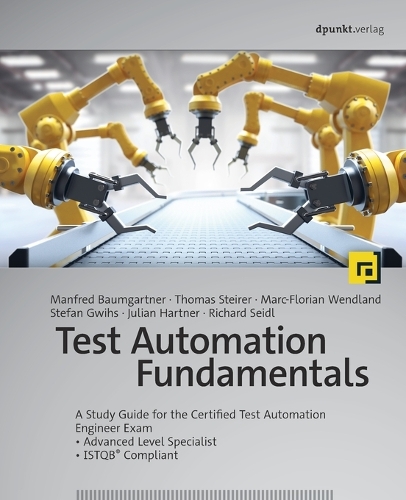
Test Automation Fundamentals: A Study Guide for the Certified Test Automation Engineer Exam * Advanced Level Specialist * ISTQB Compliant
(Paperback)
Publishing Details
Test Automation Fundamentals: A Study Guide for the Certified Test Automation Engineer Exam * Advanced Level Specialist * ISTQB Compliant
By (Author) Manfred Baumgartner
By (author) Thomas Steirer
By (author) Marc-Florian Wendland
By (author) Stefan Gwihs
By (author) Julian Hartner
By (author) Richard Seidl
Rocky Nook
Rocky Nook
17th January 2023
United States
Classifications
General
Non Fiction
Physical Properties
Paperback
330
Width 190mm, Height 234mm
Description
Test automation is an essential tool in todays software development environments. It increases testing efficiency and makes test procedures reliably repeatable.
This book provides a complete overview of how to design test automation processes and integrate them into your organization or existing projects. It details functional and technical strategies and goes into detail on the relevant concepts and best practices. The books main focus is on functional system testing.
Topics covered:
An introduction to test automation
Objectives and success factors
Preparing for test automation
Introduction to generic test automation architectures
Design and development of a test automation solution
Risks and contingencies during deployment
Metrics and reporting
Transitioning manual testing to an automated environment
Verifying a test automation solution
Continuous improvement
The appendix contains an overview of software quality characteristics according to the ISO 25010 standard, and lists potential test automation applications within this context. It also provides an introduction to load and performance testing, and a sample catalog of criteria for selecting test automation tools.
This book is fully compliant with the ISTQB syllabus and, with its many explanatory examples, is equally suitable for preparation for certification, as a concise reference book for anyone who wants to acquire this essential skill, or for university-level study.
Author Bio
Manfred Baumgartner has more than 30 years of experience in software testing and quality assurance. Since 2001, he has established and expanded the QA consulting and training services at Nagarro, a leading software testing services company. He is a board member of the Association for Software Quality and Further Education (ASQF) and the Association for Software Quality Manage-ment Austria (STEV). He is also a member of the Austrian Testing Board (ATB). He shares his exten-sive experience at numerous conferences and in his articles and books on software testing. Thomas Steirer is a test automation architect, test manager and trainer, and leads Nagarro's global test automation unit. He qualified as an ISTQB(R) Certified Tester - Full Advanced Level in 2010. He is a lecturer for test automation in the master's program for software engineering at the UAS Techni-kum in Vienna, and does research into the use of artificial intelligence for increasing efficiency in test automation. Marc-Florian Wendland is a research associate at the Fraunhofer FOKUS institute in Berlin. He has more than 10 years" experience in national and international, cross-domain research and industrial projects that involve the design and execution of test automation. He is a member of the German Testing Board (GTB) and a trainer for various ISTQB(R) programs. Stefan Gwihs is a passionate software developer and tester, and is a test automation architect at Nagarro, where he currently focuses on test automation for agile software development and DevOps. Julian Hartner is based in New York City. He is an ISTQB(R) certified quality engineer and a passion-ate software developer and test automation engineer. He currently focuses on streamlining man-ual and automated testing for CRM applications. Richard Seidl has seen and tested a lot of software in the course of his career: good and bad, big and small, old and new, wine and water. His guiding principle is: "Quality is an attitude". If you want to create excellent software, you have to think holistically and include people, methods, tools, and mindset in the development process. As a consultant and coach, he supports companies in their efforts to turn agility and quality into reality, and to make them part of corporate DNA.
